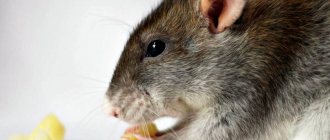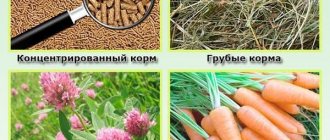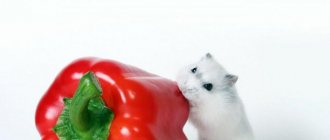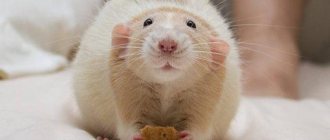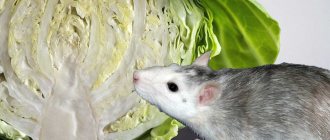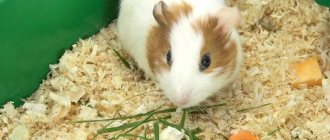Hello friends, in this table we tried to collect the most comprehensive information about what kind of food Can to give to a decorative rat and which one is better to abstain from.
If you do not find a particular fruit or vegetable , feel free to ask a question in the comments and we will add it to the table.
By the way, at the top of the table there is a “Search” field, you can enter the word you need and immediately find out whether you can give it to a rat or not - it’s convenient =)
Foods that should not be given to rats
If your pet's health is important to you, do not feed it from the table. It seems that there is nothing wrong with giving a rodent a piece of apple, chicken or cracker, but this is not so. The rat may refuse its food and instead receive a high proportion of fat and carbohydrates. It will be difficult to wean an animal accustomed to a common table, which means the end of a balanced diet.
It is strictly forbidden to give your rodent alcohol, fried, smoked, salted, pickled, fatty foods, carbonated drinks and sweets.
Special food
While shopping for standard food, you can also look for products specifically formulated for pet rats.
They are usually a food made from nutritious plant pellets. These loose seed mixtures can provide a balanced diet for your pet, but only if your rat eats the entire contents of the food. However, rodents often eat only the most delicious food and leave half of the food at the bottom of the bowl. Therefore, rat food in the form of a block is an excellent option. The pet will not be able to selectively eat a certain part of the food, and food will always be available to it.
Grain and cereals
Grains are the main product in the diet of rats, but they are not equally important. Wheat is a rich, high-calorie product; it can be given to rats, but it must be taken into account that it must be supplemented with other components. The mixture may include oats, buckwheat, corn, rye, barley or pearl barley, rice, millet or millet. These grains are not equal. Buckwheat is a dietary low-calorie product, and corn, on the contrary. Oats should be added in small quantities; excess may cause fermentation. Refined rice is low in nutrition, so it's worth finding a wild rice blend or an unrefined version of the grain.
Semolina does not contain anything useful, so this product should be excluded from the diet. Barley or wheat cereals are suitable for porridges. Porridge is useful only for weakened, emaciated animals or young animals. Adult rats should only give them as a treat.
Nuts
Nuts are full of healthy fats, protein and fiber. They can be given to pets as a healthy treat. However, they should only be offered to rats in small quantities, as they contain too much fat. But the exception is chestnuts, which are low in fat and are considered the most suitable nut for rats.
We suggest adding several types of nuts to your pet's diet and alternating them - treating your rat to one of the types once a day. The following nuts are the best choices:
- Walnuts;
- Brazil nuts;
- Almond;
- Pecan;
- Pistachios.
Chestnuts are the only type of nut that can be given in large quantities and combined with other nuts.
Vegetables and greens
Among vegetables, foods that cause fermentation are prohibited: white and red cabbage, Savoy and Brussels sprouts, as well as cauliflower. Rats can eat broccoli in small quantities. Strong gas formation is caused by radishes, turnips and radishes, as well as all types of legumes: beans, peas, beans and lentils
.
You should be careful when giving sweet peppers; some animals have the same reaction to it. You can sometimes offer boiled green beans if they do not cause gas in your pet. Carrots, zucchini, zucchini and pumpkin are delicious and healthy foods. Cucumbers in excess will cause diarrhea
.
Eggplants are only good when cooked; solanine in raw vegetables can cause poisoning. Artichokes can also only be given cooked. Potatoes will not bring any benefit to the animal
. In its raw form it is contraindicated for animals, but when cooked it acts as ballast. However, some rodents enjoy eating potatoes.
Vegetables, fruits and herbs should be given daily in small quantities - 10-12 g.
Dill, cilantro, parsley, basil and celery are healthy foods for animals and can be given every day. They are not only safe, but also help digest protein foods. Onions, garlic and wild garlic are not suitable due to phytoncides that irritate the gastrointestinal mucosa.
They should be given occasionally and in limited quantities. Acidic vegetables such as tomatoes, rhubarb and sorrel can also eat away at the delicate walls of a rodent's stomach. You should not give animals spinach either. Beets carry another danger - a laxative effect, they should be given carefully. Leaf lettuces that do not have a specific bitterness are generally suitable for animals.
Criterias of choice
If you still want to treat your little rodent with a treat, you need to understand the right choice of fruit.
The banana should not contain any green coloring, otherwise you will feed your pet solid starch. There should be small black spots on it, which means the fruit is ripe. You can also determine ripeness by smell. A yellow banana will have no odor, but the aroma of the spotted yellowish fruit will not let you pass by.
Remember, the main diet of rats: cereals, grains, dairy products and lean meat. Banana is a fruit that provides vitamins to animals. Protein is necessary for full functioning and health. It supports immunity and develops bones and muscle tissue.
Knowing all the subtleties in choosing and consuming bananas, you can not only not harm the little rodent’s body, but also please him with a pleasant treat from which he will receive the necessary vitamins.
Let us list the “top three” among such myths:
1. Rats are “scavenger” animals, so you can feed them table scraps and not entirely fresh food.
2. Rats are rodents and can only be fed grain and special food.
3. Rats should not eat meat or fish.
All this is pure fairy tales and in this article we will help you choose the right diet for your pet. So, let's make a diet:
Basic principles of proper nutrition for rats: 1. Food should always be fresh.
2. It should not contain products harmful to rats (see list below)
3. It must contain all the vitamins, minerals and other microelements the rat needs.
4. Food should be given to an adult rat 1-2 times a day (provided there is dry food in the cage), and to a baby rat 2-4 times a day.
Products that can be given to the average rat (without taking into account personal characteristics and physical condition): 1. Fruits: apples, pears, bananas, citrus fruits, plums, peaches, apricots, dates, grapes, persimmons, cherries, raisins, dried fruits...
2. Berries: raspberries (they love them very much!), blueberries, wild strawberries, strawberries, currants, cranberries...
3. Vegetables: potatoes (boiled!), cabbage (raw and boiled) - white, broccoli, cauliflower, kohlrabi, Brussels sprouts, tomatoes and cucumbers (raw), radishes, carrots, pumpkin, melon, watermelon, onions, garlic, eggplants and etc.
4. Greens: dill, parsley, celery, cilantro, radish greens.
5. Meat: boiled meat (any), fish, seafood; meat food for small kittens, meat baby food, bones (unroasted).
6. Protein foods: yogurt (preferably without filler, not very fatty), cottage cheese, kefir, fermented baked milk, baby food.
7. Grains: corn, oats, wheat, millet, flax grains, pumpkin and sunflower seeds, barley, oatmeal, etc.
8. Soy products.
9. Dry food: dry pasta, nuts, dried dandelion and nettle greens.
10. Other: boiled pasta, porridge, low-fat broths, bread, crackers, boiled rice...
11. Prepared foods: see “Recommended foods and treats”
12. Vitamin supplements: drops, fish oil, special. vitamins for rodents
13. Mineral supplements: chalk, mineral stones for rodents.
For diets for rats that suffer from obesity, dermatitis and other diseases, see “Veterinary Medicine” in the appropriate section.
Foods that should not be given to rats:
2. Too fatty
3. Very salty
4. Spoiled products
5. Chocolate and products containing it
6. Carbonated and alcoholic drinks
7. Raw: potatoes, beans, red and Brussels sprouts, artichokes, tofu (bean curd)
Fruits
All citrus fruits should be immediately excluded from the diet of rats due to acidity.
. Occasionally you can give a piece of sweet tangerine. Forest and garden berries must be sorted according to their acid level. Thus, cranberries, which are useful in many respects, should be given with caution because of their taste.
Sweet cherries are more suitable than sour cherries. Never give animals seeds from fruit trees or citrus fruits.
They can be poisonous to rodents. You should pay attention to the special properties of fruits. Chokeberry and bird cherry strengthen, and plum weakens. This must be taken into account when choosing food. Pear can cause fermentation in some individuals. Watermelons and melons can be given in small quantities and only in season, as they accumulate nitrates.
Dried fruits are too sweet and may cause fermentation. They should be given carefully, as a treat.
Scientists' answer
Scientists from the UK were interested in the question of why mice love cheese. They conducted a number of experiments with mammals.
Experience has shown that mice prefer to eat plant foods, and they do not like the smell of cheese at all. Particularly odorous varieties evoke a feeling of danger, and they try to avoid the suspicious object.
An animal living in the wild will eat cereals and fruits, and will only eat other food in case of severe hunger. In the forest or in the field you will not find products created by man. Therefore, it is not surprising that the mammal loves natural food. It looks and smells safe.
Scientists from the British organization Pest Control UK became interested in the results of their colleagues and conducted their own experiment. They used traps with various baits:
- cheese;
- apple;
- chocolate.
The results showed that mice eat cheese. The trap was set with this delicacy, and they liked to run into it the most. But chocolate did not arouse any interest among the animals.
It is likely that the experiment involved different species of mice and different types of treats, which is why the results are so different from each other.
On a note!
Exterminators assure that you should take sunflower seeds, flour, wheat, and unrefined oil as bait. Pests love this kind of food more.
Dairy
The decorative rat eats dairy products with pleasure, but some animals have lactose intolerance. Regular milk should not be given to a rodent at all, but fermented milk in small quantities will not harm. However, you should not feed your pet rat sour cream, cheese or cream due to the high fat content of these products.
Animals benefit from cottage cheese, fermented baked milk, yogurt without additives and sugar, yogurt, kefir, acidophilus. All these products should have a fat content of 2-4%. Low-fat foods are less natural. “Sour milk” should be chosen with a short shelf life, preferably children’s milk or from farms.
A little history
Who knows where this myth came from. Most likely, the traces lead to the Middle Ages. Before the invention of the refrigerator, storing food was much more difficult, so everyone got out of the situation as best they could: meat was attached to a hook under the ceiling, grain was kept in bags or barrels, and large circles of cheese were covered with wax or wrapped in linen. In those days, a hungry mouse agreed to eat anything. Meat hanging from the ceiling was harder to get, wheat or cheese was much easier to access. But the loss of several grains from the bag is not so noticeable, and teeth marks are treacherously visible on a piece of cheese. This may have led many to believe that mice love cheese. Even if in fact they only eat it because it turned out to be their only prey.
Animal proteins
Twice, or even three times a week, animals are supposed to receive animal proteins. The following can be served at the table:
- boiled lean meat;
- hard-boiled chicken or quail eggs;
- mealworm, zoophobus (zophobas), gammarus;
- seafood;
- high quality cat or dog dry food.
From poultry, you can give chicken breast, but it is better to feed turkey, which is not fed with growth hormones. From ungulates you can take beef, lean lamb, and game. It is better to grind the boiled yolk with water so that the rat does not choke. You should not feed fatty pork and its derivatives to rats.
Store-bought beef should be soaked for 2-3 hours before cooking, and chicken should be boiled in several waters to remove harmful substances. Rats can suffer from allergies.
Meat
Meat and fish are recognized as the main sources of protein. It is also very important to introduce hearts, kidneys, liver and tubular bones of birds into the diet of a domestic rat. Feed your pet only meat and fish that are not too fatty. The best feeding option is pre-boiled meat, cut into small pieces. Never give your animal high-temperature food; wait until the meat cools down. It is worth noting that frozen meat is not suitable for feeding rats. An excellent addition to a healthy rat diet would be low-fat broth without various spices and additives.
Features of rat nutrition
Coming up with a list of what rats eat is almost impossible because they eat everything. The only exceptions are absolutely inedible things, although even wires and polyethylene can be chewed and partially swallowed. However, for all their indiscriminateness, rats treat food in the wild quite reasonably. In the wild, they never overeat, so they do not become obese. If a rat is lucky enough to get a high-calorie piece, it eats less food. If what rats eat is low in nutrition, the amount consumed increases accordingly. If there is a lack of some minerals or vitamins in their body, these rodents look for foods with a high content of the necessary substance.
It should be noted that rats (domestic or wild - it makes no difference) eat all the time. If you forget to feed your pet for at least two days, it will die. Therefore, in the wild, animals are constantly in search of food, and, if possible, they create reserves.
Poisonous grass
So, we figured out what rats eat. But you also need to have an idea of what is dangerous for them. Especially if your pet has the opportunity to move freely around the apartment, and you are a fan of home gardening. If he can only get potato, cherry, tobacco, and euphorbia leaves from your hands (that is, you just need to check that the animal does not eat them), then he can gnaw indoor flowers without your knowledge. The following house plants are poisonous to rats:
- dieffenbachia;
- indoor feces;
- azalea;
- begonia;
- ivy (any variety);
- amaryllis;
- cyclamen.
The worst thing is that the rat cannot be forbidden to eat flowers, or hide them so that he cannot get to them. If you have such plants in your house, you will have to keep the animal in a cage.

